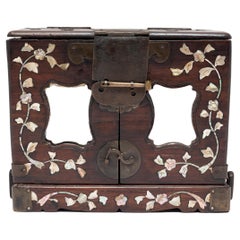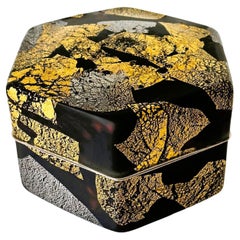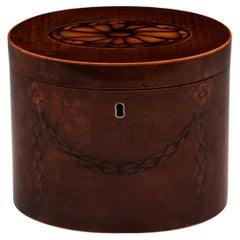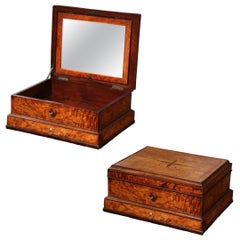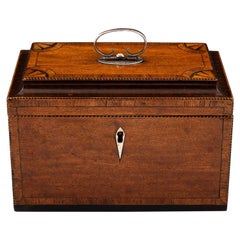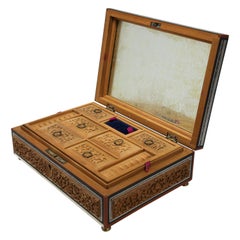Inlay Boxes
to
55
414
59
4
51
213
150
63
40
63
25
7
3
3
7
2
5
7
8
7
4
50
33
32
19
18
14
13
11
8
7
5
4
3
3
2
2
358
206
135
123
82
259
179
272
135
120
98
66
Height
to
Width
to
477
451
466
12
9
7
6
6
Technique: Inlay
Chinese Hardwood Jewelry Box with Mother of Pearl Inlay, c. 1850
Located in Chicago, IL
Long ago, this elegant rosewood box was used by a Qing-dynasty lady to store her favorite pieces of jewelry, each drawer filled with jades, pearls, coral necklaces, and hair pins. Th...
Category
Mid-19th Century Chinese Qing Antique Inlay Boxes
Materials
Brass
Large Japanese Kazaribako Glass Box Ancient Captial Kyohei Fujita
Located in Atlanta, GA
A Kazaribako "Ornamented Box" made of glass by Japanese artist Kyohei Fujita (1921-2004) circa 1990s. The hand-blown glass box is substantial in size and weight. It features a hexago...
Category
1990s Japanese Modern Inlay Boxes
Materials
Silver
Georgian Oval Tea Caddy
Located in Northampton, GB
From our Tea Caddy collection, we are delighted to offer this Georgian Oval Tea Caddy. The Tea Caddy of elongated Oval form veneered in Harewood with Box...
Category
Late 18th Century British George III Antique Inlay Boxes
Materials
Brass
$5,100
19th Century French Burl Elm Inlaid Jewelry Box with Drawer & Inside Mirror
Located in Dallas, TX
Decorate a coffee table or a shelf with this elegant antique box. Created in France circa 1880, the rectangular cabinet is decorated with an elegant floral inlaid star motif on the t...
Category
Late 19th Century French Napoleon III Antique Inlay Boxes
Materials
Mercury Glass, Elm, Burl
Georgian Satinwood Tea Chest with Secret Compartments
Located in Northampton, GB
Georgian Tea Chest with Boxwood & Ebony Checkered Stringing
From our Tea Caddy collection, we are delighted to offer this Rare Georgian Satinwood Tea Chest. The Tea Chest of rectang...
Category
Late 18th Century British Georgian Antique Inlay Boxes
Materials
Silver
Anglo-Indian Footed Box with Lidded Compartments, 19th Century
Located in Moreno Valley, CA
19th century Anglo-Indian wooden box fitted with various compartments finely hand carved.
The top is finely hand carved with the Taj Mahal.
The interior with removable hand carved nine-lidded compartments, the front cover has a mirror, the whole exhibiting very fine workmanship.
This fine late Victorian Anglo-Indian box from India is in great condition for it age.
A beautiful example of an Anglo-Indian fine art...
Category
Late 19th Century Indian Anglo-Indian Antique Inlay Boxes
Materials
Sandalwood
Agito Watch Winder Cabinet with glass front, marquetry decoration and lacquered
By Procreo
Located in London, GB
Agito watch cabinet offers 6 automatic mechanical watch winders in the main section of the watch box with pre-programmed watch rotators offering personal...
Category
2010s British Modern Inlay Boxes
Materials
Brass
Moroccan Moorish Middle Eastern Large Inlaid Wood Micro Mosaic Jewelry Box
Located in Studio City, CA
Stunning mosaic design, this intricate wood box is made from multiple micro pieces of wood with some possible bone inlays. Gorgeous craftsmanship. A true work of art.
Would be a ...
Category
20th Century Moorish Inlay Boxes
Materials
Wood
19C Anglo Indian Highly Carved Sadeli Mosaic Sarcophagus Sewing Box
Located in Dallas, TX
PRESENTING A GORGEOUS 19C Anglo Indian Highly Carved Sadeli Mosaic Sarcophagus Sewing Box.
Made in Bombay, India circa 1860-80.
Box made of sandalwood with highly carved teak wood reliefs and panels on all sides.
Edged with bone and ebony veneers and glorious sadeli mosaic, made from tiny pieces of faux ivory, pewter, green semi-precious stone.
The box is in a sarcophagus form with domed lid.
The original brass carry handles are on the sides.
The interior is in great condition and consists of a removeable mirror under the lid portion, with the original red velvet lining behind it.
The base is removeable and contains a number of lidded compartments.
6 of the interior lids on the base, are each inlaid with sadeli mosaic banding. The rest are also carved and chased.
The interior is fully complete with 7 lidded faux ivory/bone, thread canisters with sadeli domes and the original bone thimble.
The box sits on 4 brass ball or bun feet with the original velvet lining on the base.
Some minor repairs and losses, but this box is fully complete. This is ‘rare’ as many of these boxes have not survived in such condition!
Included in the sale are 2 photos that were in the box (under the base tray). Interestingly, one of them is a view of downtown Nassau, New Providence (Bermuda) from the early 20C and stamped on the rear. What a ‘journey’ this piece has made! Made in India … travelled to Bermuda, probably via Britain … back to Ireland (where we bought it) …. then to Texas!
These boxes were made by superb Indian craftsmen, specifically for sale to the ruling British elite. These types of boxes, carved padouk and sandalwood, (whilst beautiful and superbly crafted) were of a lesser quality, than the more profusely and intricately mosaic inlay, tortoiseshell and ivory boxes, made for the British ‘Upper Classes’ in the areas of Bombay and Vizagapatam. These type of boxes were much more affordable back in 1880 (and indeed today) and would probably have been bought by mid-level diplomats, civil servants or visitors.
Sewing boxes (in general), were in EVERY Victorian home in Britain in the 19th Century and like other boxes etc were ‘status symbols’ of your place in society! The more ornate the box, the more ‘Upper Class’ you were!
Of it’s type, this one, is one of the very higher quality one’s, than the norm!
SADELI MOSAIC: “Anglo Indian boxes were made in India for the English residents from the early part of the 18th century. They were brought back or sent back to England usually by the people who had commissioned them. From the beginning of the nineteenth century they were imported more commercially, although not in any significant numbers until the middle decades. They were very highly valued, especially the early ones, to the extent that the designs were copied on late 19th and early 20th century tins.
The ancient art of Sadeli Mosaic is said to have been introduced from Shiraz in Persia via Sind to Bombay, a long time before the Anglo Indian boxes were made. It was a technique, which required a high degree of skill and patience. It was executed very lavishly, in that the frequent cuts wasted a great amount of the precious materials used. The workmanship was however more than commensurable to the value of the materials.
Ivory, silver, pewter (or other metals), wood and horn were cut into faceted rods which were bound together to form geometric patterns. When the glue has set, the rods were sliced in transverse sections. This gave the maker a number of angled circular pieces in the original pattern. Several variations of patterns could be achieved by combining the materials in different ways. The ivory was sometimes dyed green to give an extra color.
The mosaic pieces in a combination of patterns, often separated by ivory, ebony, horn or silver stringing were used to veneer sandalwood boxes. In the early boxes, which date from the turn of the 18th to the 19th century, there are large panels of mosaic covering tops and sides of boxes. It took incredible skill to cover such large areas without any shakes or wavering of the pattern. The corners and joins on these boxes are impeccably matched.
The makers (reputed to be Persian) of Sadeli mosaic made in the first two decades of the 19th century displayed a total understanding of the qualities of the different materials they used. They combined substances, which can expand and contract according to atmospheric conditions with others, which are hard and unyielding. The result was a sharp definition of the lines and patterns, which made up the whole design.
On the early boxes the designs look deceptively simple. The fact is, they emerged from a culture, which had mastered geometry and understood how to generate a pattern from a set number of points. The patterns are so harmoniously combined that their incredible complexity is not immediately apparent.
The earliest Sadeli boxes...
Category
19th Century Indian Anglo-Indian Antique Inlay Boxes
Materials
Bone, Sandalwood, Teak
Early 19th Century Oak Candle box from England
Located in High Point, NC
Early 19th century oak candle box from England. The box has a wonderfully hand carved top with two opposing birds flanking a central pineapple. These symbols were also synonymous with welcoming guests into your home. Below the birds, there is a lovely small carved piece over the lid of the candle box. The lid is beveled around the edge for added design detail. The sides of the box are simple and the front has beaded edges, which flank the central panel. That is decorated with a crossed knife...
Category
Early 19th Century English Georgian Antique Inlay Boxes
Materials
Fruitwood, Oak
19th Century English Regency Mahogany Tea Caddy with Seashell Inlay
Located in Stamford, CT
19th century English Regency Mahogany sarcophagus form tea caddy with satinwood and holly wood seashell inlaid top. The flame mahogany top framed by twin...
Category
Early 19th Century Regency Antique Inlay Boxes
Materials
Bone, Mahogany, Satinwood, Holly
Decorative Treasure Box with Warm Color Straw Marquetry Subway Inlay Handcrafted
Located in Warsaw, PL
DECORATIVE BOX 03
Inlay scheme: Subway
Colour scheme: Warm
Available in individuals colors
MATERIALS: MDF, painted rye straw, brass.
DIMENSIONS (cm): 12x12x6,5.
Packaging dimensions ...
Category
21st Century and Contemporary Ukrainian Arts and Crafts Inlay Boxes
Materials
Brass
Maranao Silver Inlaid Betel Box, c. 1900
Located in Chicago, IL
Decorated with silver inlay and cloaked in an antique patina, this curious brass case is an early 20th century betel nut box, attributed to the Maranao people of the island of Mindan...
Category
Early 20th Century Philippine Folk Art Inlay Boxes
Materials
Brass, Silver
Outstanding quality antique Victorian rosewood and burr maple tea caddy
Located in Ipswich, GB
Outstanding quality antique Victorian rosewood and burr maple tea caddy, having a quality antique Victorian tea caddy of sarcophagus form with beautiful swirling floral motifs along ...
Category
19th Century Antique Inlay Boxes
Materials
Glass, Maple, Rosewood
Mid 19th Century English Gentleman’s Traveling Chest by J.Braman, Circa 1860
Located in Sarasota, FL
An English gentleman’s traveling chest circa 1860, made by J.Braman. Framed in brass with ornate brass floral inlay. The interior is lined with red velvet and red leather with gilt t...
Category
Late 19th Century British Victorian Antique Inlay Boxes
Materials
Brass
A Georgian Estate Made Letterbox
Located in London, GB
A most charming estate made country house letter box with delicately inlaid LETTER BOX to front.
English, George III
H 27 x W 23 x D 15 cms
Category
Early 18th Century British George III Antique Inlay Boxes
Materials
Mahogany
English Georgian Mahogany Tea Caddy Box
Located in Queens, NY
English Georgian (18/19th Century) mahogany tea caddy box on bracket feet with inlaid satinwood and ebony banding and a hinged stepped up top with a brass handle and escutcheon
Category
19th Century British Georgian Antique Inlay Boxes
Materials
Wood
1960s Vintage Moroccan Inlaid Hexagonal Wood Box
Located in Moreno Valley, CA
1960s Handcrafted Bone Inlaid Trinket Moroccan Wood Trinket Box.
Handmade artisanal mid century inlaid trinket decorative lidded Moroccan box.
This hexagonal shaped decorative box ha...
Category
Mid-20th Century Moroccan Folk Art Inlay Boxes
Materials
Bone, Fruitwood
Italian Pill Box Micro Mosaic Millefiori
Located in New York, NY
A beautiful oval Italian brass pill box with an inlayed floral glass micro mosaic millefiori design and twisted rope top lid, finished with a brass ...
Category
Mid-20th Century Italian Inlay Boxes
Materials
Brass
Rectangular Trinket Box Made of Marquetry and Brass by Ginger Brown
By Ginger Brown
Located in Bourguebus, FR
This trinket box is handcrafted with shell marquetry and brass trims.
The box is hinged and the interior is lined with a high quality black microsuede.
A very unique piece you ...
Category
21st Century and Contemporary French Art Deco Inlay Boxes
Materials
Brass
Biedermeier Jewelry Box, Walnut, Ebony, Maple, South Germany circa 1830
Located in Regensburg, DE
Beautiful Biedermeier Jewelry or Make-up box from South Germany circa 1830.
Inside with hinged mirror. A long drawer at the bottom front.
Restored and hand-polished with shellac.
Category
1830s Biedermeier Antique Inlay Boxes
Materials
Brass
Set of 3 Japanese Inro Pill Boxes
Located in Munich, DE
These three antique handcrafted inro cases, are a wonderful collection of Japanese Sagemono (hanging object). These inro have several sections stacked ...
Category
Mid-20th Century Japanese Anglo-Japanese Inlay Boxes
Materials
Bone, Bamboo, Wood
$920 / set
Fine Miniature Japanese Kodansu with Lacquer Inlays
Located in Atlanta, GA
A fine Japanese miniature kodansu constructed from Kaki wood (Persimmon) circa 19th century, late Meiji period. With its expressive exotic wood grains and exposed tenon construction,...
Category
Late 19th Century Japanese Meiji Antique Inlay Boxes
Materials
Wood
19th Century, French Hand Carved Marquetry Walnut Liquor Cellar
Located in Sofia, BG
Foldable 19th Century French hand carved marquetry walnut liquor cellar.
Overall good condition except the top of the box which was burned quite bed and no restorations have been ma...
Category
Late 19th Century French Antique Inlay Boxes
Materials
Walnut
Superb Antique Folk Art Parquetry Casket Styled Writing Box or Lap Desk
Located in Hamilton, Ontario
This exquisite antique parquetry writing box or lap desk is unsigned, but presumed to have been made in Canada in approximately 1900 in a Folk Art style. The box itself, including th...
Category
Early 20th Century Canadian Folk Art Inlay Boxes
Materials
Softwood
Decorative Box Red Straw Marquetry Inlay Handmade Biomaterials
Located in Warsaw, PL
DECORATIVE BOX 01
Inlay scheme: Weave
Colour scheme: Ruta
Available in individuals colors
MATERIALS: MDF, painted rye straw, brass.
DIMENSIONS (cm): 20?20x10,5.
Packaging dimen...
Category
21st Century and Contemporary Ukrainian Arts and Crafts Inlay Boxes
Materials
Brass
$849 Sale Price / item
20% Off
18th Century French Louis XVI Marquetry Secretaire or Desk
Located in Winter Park, FL
An 18th century French Louis XVI marquetry secretaire, or secretary desk with bookcase. Beautifully made with book matched veneer of mahogany and fine inlay of walnut and mahogany. I...
Category
Late 18th Century French Louis XVI Antique Inlay Boxes
Materials
Brass
Antique Victorian Traveling Desk With Ebony and Mother-of-Pearl Banding
Located in Morristown, NJ
Victorian English bird's eye maple lap desk, with ebony and mother-of-pearl inlay. The dome shaped top has a brass shield medallion in the center. The interior has a vibrant purple f...
Category
1880s English Victorian Antique Inlay Boxes
Materials
Mother-of-Pearl, Birdseye Maple, Ebony
A 19th Century Brass Bound Mandalay Teak Campaign Dressing Box, Burma Circa 1860
Located in Ottawa, Ontario
These boxes were made for British military officers who were posted in Burma (now Myanmar) & India during the days of British rule.
The brass & copper bound teak case is profusely ...
Category
Mid-19th Century Burmese British Colonial Antique Inlay Boxes
Materials
Brass, Copper, Iron
Tunbridge Wooden Trinket Box England, 1870s
Located in Stamford, CT
Tunbridge trinket box made in England in the 1870s. Wooden floral design. Tunbridge wooden trinket box made in England in the 1870s. Tunbridge war...
Category
19th Century English Antique Inlay Boxes
Materials
Hardwood
Fratelli Toso a millefiori murrine vase from Murano, ca. 1910
Located in Aachen, DE
A millefiori murrine vase by the Toso brothers, made on the island of Murano around 1910. The lovely colored and decorated Murrine were cut from glass canes, arranged on a plate, fus...
Category
1910s Italian Arts and Crafts Vintage Inlay Boxes
Materials
Glass, Art Glass, Blown Glass, Murano Glass, Murrine
$774 Sale Price
20% Off
Handmade Decorative Treasure Box with Checkerboard Straw Marquetry Black White
Located in Warsaw, PL
DECORATIVE BOX 01
Inlay scheme: Weave
Colour scheme: B&W
Available in individuals colors
MATERIALS: MDF, painted rye straw, brass.
DIMENSIONS (cm):20x20x10,5.
Packaging dimensions (c...
Category
21st Century and Contemporary Ukrainian Arts and Crafts Inlay Boxes
Materials
Brass
$849 Sale Price / item
20% Off
Antique Dutch Marquetry Walnut Box in Octagonal Shape, Circa 1880.
Located in New Orleans, LA
Antique Dutch Marquetry Walnut Box in Octagonal Shape, Circa 1880.
Category
Late 19th Century Dutch Antique Inlay Boxes
Materials
Walnut
1950's Decorative Brutalist MCM Inlaid Burl Speciman Wood Box by Norman Brumm
Located in Red Lion, PA
1950s Decorative Brutalist MCM Inlaid Burl Specimen Wood Box by Norman Brumm
This small but striking 1950s decorative box by Norman Brumm showcases the artist’s signature Brutalist ...
Category
1950s Mid-Century Modern Vintage Inlay Boxes
Materials
Brass
Very Fine Biedermeier Period Tea Caddy of Bombe Form in Exotic Woods, circa 1830
Located in Ottawa, Ontario
A very fine and visually striking Biedermeier Period tea caddy of exceptional quality, demonstrating a highly elevated form and a most complex application of exotic woods. The hinged...
Category
Early 19th Century German Biedermeier Antique Inlay Boxes
Materials
Zebra Wood, Yew, Amboyna, Satinwood
Montagnani Gilded Metal and Wood Marquetry Box, circa 1970
By Montagnani
Located in Atlanta, GA
Immerse yourself in the artistry of Montagnani Firenze with this extraordinary box, a rare Italian masterpiece crafted circa 1970. A true testament to Mid-Century modernist design, i...
Category
1970s Italian Mid-Century Modern Vintage Inlay Boxes
Materials
Metal, Brass
NAPOLEON III Paris 1860 Travel Foldable Writing Desk Box In Precious Woods & Aba
By Napoléon III
Located in Miami, FL
An antique Napoleon III traveler portable writing-desk box.
This is a gorgeous portable writing desk-box, created in France during the period of emperor Napoleon III, circa 1860. Th...
Category
1860s French Napoleon III Antique Inlay Boxes
Materials
Leather, Shell, Wood
$1,372 Sale Price
30% Off
Fine Cloisonné Enamel Silver Pill Box
Located in Worcester, GB
Fine Cloisonné Enamel Silver Pill Box
A finely crafted kidney-shaped sterling silver pill box, delicately enamelled throughout in vibrant shades of cobalt blue, turquoise, burgundy...
Category
Mid-20th Century Indian Inlay Boxes
Materials
Sterling Silver, Enamel
An antique early 20th century silver and niello box, Siam circa 1920
Located in Central England, GB
This very interesting and decorative silver box was made in Siam now Thailand circa 1920. It is made from solid high grade silver (tested) and is beautifully decorated with niello w...
Category
Early 20th Century Thai Other Inlay Boxes
Materials
Silver
Unusual Antique Victorian Quality Inlaid Coromandel Wood Writing Box
Located in Suffolk, GB
Unusual antique Victorian quality inlaid coromandel wood writing box having quality inlaid coromandel wood lift up tops opening to reveal a green leather writing surface opening to r...
Category
19th Century English Victorian Antique Inlay Boxes
Materials
Other
Biedermeier Box, Walnut on Oak, Inlays, South Germany circa 1850
Located in Regensburg, DE
Large, high-quality late Biedermeier casket box in walnut with precious wood inlay and inlaid lid motif.
Walnut veneered on maple and solid with numerous inlays in precious woods, m...
Category
1840s German Biedermeier Antique Inlay Boxes
Materials
Ebony, Maple, Oak, Walnut
Biedermeier Box, Mahogany, Burlwood, Oak, Inlays, South Germany circa 1840
Located in Regensburg, DE
Beautiful, high-quality late Biedermeier casket box from southern Germany, circa 1840.
Mahogany and (probably walnut) burl wood veneer on oak and maple.
Numerous inlays in maple and...
Category
1840s German Biedermeier Antique Inlay Boxes
Materials
Brass, Iron, Gold Leaf
Spanish Colonial Era 18th/19th Century Inlaid Cedar Wooden Chest Box Trunk
Located in Forney, TX
A charming scarce Spanish Colonial era parquetry inlaid cedar legged storage chest (large table box / small trunk) with nicely aged warm rich dark patina. circa 1790
Rustic handmade...
Category
18th Century Spanish Colonial Antique Inlay Boxes
Materials
Iron
18th-century Dutch-colonial Peranakan mother-of-pearl casket with silver mounts
Located in Amsterdam, NL
An Indonesian Peranakan mother-of-pearl inlaid mastic sirih casket with silver mounts
Jakarta (Batavia), circa 1720-1730, the silver hinges marked for Batavia, maker’s mark HS or SH...
Category
Mid-18th Century Indonesian Dutch Colonial Antique Inlay Boxes
Materials
Silver
Napoleon Linder 1890 Paris Hinged Vesta Matches Box in Niello and .900 Silver
Located in Miami, FL
Vesta matches box designed by Napoleon Linder.
Very rare hinged box, created in Paris France at the silversmith atelier of Napoleon Linder. This is a vesta matches box crafted in ...
Category
Late 19th Century French Art Nouveau Antique Inlay Boxes
Materials
Silver, Sterling Silver
$367 Sale Price
30% Off
19thC Campaign Style Rosewood with Brass Inlay Stationary Letter Box
Located in Port Jervis, NY
Fabulous and large rosewood and teak fitted letter writing box with brass inlay. Numerous cubbies with lids for various items. Slotted back panel fo...
Category
1850s Indian Anglo-Indian Antique Inlay Boxes
Materials
Brass
Fine Korean Iron Box with Silver Inlay Joseon Dynasty
Located in Atlanta, GA
A fine Korean iron box that was traditionally used to store tobacco leaves dated to the late Joseon Dynasty circa 19th century. The box is made from iron and has a heavy weight, although the wears along the edges of the lid and base exposes a bronze metal color underneath, indicating the iron metal may contains a high level of copper. The surface was beautifully decorated with elaborate silver inlay that covers the entire surface except the base. The extraordinary workmanship depicts a pair of deer within the circled square (shape of heaven and earth) and a lined background on the long sides and a crane with spread wings on the shorter sides. Both animals were associated with longevity. Their eyes were highlighted with copper inlay, adding a lively touch to the animation. The lid is centered with a Chinese character "Xi" (Paired-Hui in Korean), which means double happiness. (In Chinese culture, it is often used in a wedding ceremony). The large symbol was set on geometrical background of tightly scrolling diamond pattern surrounded by stylized Ruyi mushroom heads, another floral longevity symbol. Archaic fret cloud band borders the entire perimeters of the lid and the container.
Tobacco was introduced to Korean in the first half of the 17th century and gradually gained popularity. When the tobacco was started being smoked in shredded form instead of rolled leaves, there rose the production of the smoking accessories, with some in fine quality as luxury items for the elite. The accoutrement such as this box is a fine example made in late Joseon dynasty, using extensive silver inlay, a technique called "jjoeum-ipsa", in which the silver wires were hammered into the scorched iron surface to create the elaborate design.
Similar boxes with variation of shape and motifs are in the collection of several major museums. Compare the box with item Gu 754 in the National Museum of Korea; item 22.78 in MET NYC and M.240:1, 2-1926 in V& A Museum in London. The most closely related example we found is item C232 in the collection of the Museum of East Asian Art...
Category
19th Century Korean Other Antique Inlay Boxes
Materials
Silver, Copper, Iron
Marqueterie de paille Boîte
Located in VILLENEUVE-LÈS-AVIGNON, FR
Marqueterie de paille, boîte en bon état du XIXe siècle
Category
Late 19th Century French Napoleon III Antique Inlay Boxes
Materials
Straw
19th Century Napoleon III Burl Wood Sewing Box
Located in Paris, FR
Varnished, burl wood sewing box, decorated with Greek frieze and brass inlays. The box contains a mirror and sewing utensils made of bone and brass, as...
Category
19th Century French Napoleon III Antique Inlay Boxes
Materials
Brass
Miniature Table Top Drawered Chest Circa 1920
Located in Lambertville, NJ
A beautifully made fully functional miniature chest of drawers. This three-drawer chest of mahogany with inlaid panels of satinwood and pencil inlay. Only 11 inches tall, this chest ...
Category
1920s European Vintage Inlay Boxes
Materials
Brass
19th Century Anglo Indian Inlaid Mosaic Box With Drop Front and Drawers
Located in Stamford, CT
19th Century Anglo Indian fall front box with six drawers with metal pulls. The exterior and interior inlaid throughout with bone and various woods. Intricate geometric designs cover...
Category
Mid-19th Century Antique Inlay Boxes
Materials
Bone, Fruitwood, Holly
French Sevres Louis XVI Wood Mirror Vanity Box, 19th Century
Located in Lisbon, PT
A French 19th century travelling classic case box for the personal items of the aristocracy ensuring that toiletries and other beauty essentials stay organized and secure.
A stunning...
Category
19th Century French Louis XVI Antique Inlay Boxes
Materials
Metal, Brass, Bronze
$3,920 Sale Price
20% Off
Antique Philippines Silver Inlay Betel Nut Box
Located in Montreal, QC
This is a fine example of an early 20th C rectangular bronze betal nut box with beautiful and elaborate silver inlay from Mindanao in the Philippines. The box has a handle on each si...
Category
Early 1900s Philippine Antique Inlay Boxes
Materials
Silver
straw marquetry box attributed to Jean Michel Frank
Located in Brooklyn, NY
This beautiful box with straw marquetry is attributed to Jean Michel Frank as it is similar in size and pattern with his work.
Box is unsigned but in good condition, red leather back.
Category
Mid-20th Century French Art Deco Inlay Boxes
Materials
Straw
$1,680 Sale Price
30% Off
Unique 17th Century Miniature Japanese Namban Lacquer Miniature Dollhouse Chest
Located in Amsterdam, NL
A unique and exceptional Japanese miniature or dollhouse export lacquered chest
Kyoto, circa 1620-1640
The chest of rectangular shape with a domed lid, decorated in Transition-style, in gold hiramaki-e on a black background within reserved lobed cartouches decorated with landscapes animated with birds and rabbits, on a shagreen or samegawa background. The borders are decorated with geometric friezes, the box with gilt-copper mounts, the interior decorated in red lacquer.
Measures: H 9.2 x W 14.5 x D 7.2 cm
This miniature is of exceptional quality and a perfect copy of the famous large size Transition-style coffers. It was most likely ordered by a Dutch lady for her dollhouse (poppenhuis), like the famous Petronella Oortman (1656-1716) doll-house, which is now one of the highlights in the collection of the Rijksmuseum Amsterdam, or Petronella Oortmans-de la Court’s (1624-1707) dollhouse in the collection of the Centraal Museum Utrecht. Sara Rothé of Amsterdam in 1743 ordered a miniature black lacquered ivory tripod table with gold chinoiserie decoration by Jurriaan Buttner (Monika Kopplin, European Lacquer, 2010, p. 56).
Other Japanned dollhouse...
Category
17th Century Japanese Edo Antique Inlay Boxes
Materials
Shagreen, Cypress
Anglo-Indian Inlaid Elephant Motif Box
Located in Los Angeles, CA
Anglo-Indian inlaid box with elephant motif (circa 1920s).
Dimensions:
14"H x 19.5"W x 13"D.
Category
1920s Indian Vintage Inlay Boxes
Materials
Wood
19C Anglo Indian Highly Carved Teak Sadeli Mosaic Inlaid Sewing Box
Located in Dallas, TX
PRESENTING A LOVELY 19C Anglo Indian Highly Carved Sadeli Mosaic Inlaid Sewing Box.
Made in Bombay, India, circa 1880.
The box is made of sandalwood with highly carved raised teak wood panels on all sides, depicting temple scenes, animals and foliage.
The box is in a sarcophagus form.
It is edged in bone (and we can tell it is bone and not ivory, from the color and evidence of capillaries, which are not found in ivory), and banded with Bombay Sadeli mosaic and ebony veneer.
The lid opens to reveal a removable tray with various open compartments and lidded compartments. 5 lidded compartments, 1 unlidded compartment and 8 holders for thimbles, etc
The tray lifts to reveal a blue velvet (original) lined section, for storing jewelry etc, with sections for collars etc.
The inside of the lid has a removable mirror (the mirror is missing on this one but can easily be replaced). Behind the mirror is the original green velvet lining.
It has its original brass carry handles on the sides and sits on 4 silvered button feet (of recent origin).
Some repairs to the exterior and condition issues (priced accordingly), but still a LOVELY COLLECTIBLE box!
These boxes were made by superb Indian craftsmen, specifically for sale to the ruling British elite. These types of boxes, carved padouk and sandalwood, (whilst beautiful and superbly crafted) were of a lesser quality, than the more profusely and intricately mosaic inlay, tortoiseshell and ivory boxes, made for the British ‘Upper Classes’ in the areas of Bombay and Vizagapatam. These type of boxes were much more affordable back in 1880 (and indeed today) and would probably have been bought by mid-level diplomats, civil servants or visitors.
Sewing boxes (in general), were in EVERY Victorian home in Britain in the 19th century and like other boxes etc were ‘status symbols’ of your place in society! The more ornate the box, the more ‘Upper Class’ you were!
SADELI MOSAIC: “Anglo Indian boxes were made in India for the English residents from the early part of the 18th century. They were brought back or sent back to England usually by the people who had commissioned them. From the beginning of the nineteenth century they were imported more commercially, although not in any significant numbers until the middle decades. They were very highly valued, especially the early ones, to the extent that the designs were copied on late 19th and early 20th century tins.
The ancient art of Sadeli Mosaic is said to have been introduced from Shiraz in Persia via Sind to Bombay, a long time before the Anglo Indian boxes were made. It was a technique, which required a high degree of skill and patience. It was executed very lavishly, in that the frequent cuts wasted a great amount of the precious materials used. The workmanship was however more than commensurable to the value of the materials.
Ivory, silver, pewter (or other metals), wood and Horn were cut into faceted rods which were bound together to form geometric patterns. When the glue has set, the rods were sliced in transverse sections. This gave the maker a number of angled circular pieces in the original pattern. Several variations of patterns could be achieved by combining the materials in different ways. The ivory was sometimes dyed green to give an extra color.
The mosaic pieces in a combination of patterns, often separated by ivory, ebony, Horn or silver stringing were used to veneer sandalwood boxes. In the early boxes, which date from the turn of the 18th to the 19th century, there are large panels of mosaic covering tops and sides of boxes. It took incredible skill to cover such large areas without any shakes or wavering of the pattern. The corners and joins on these boxes are impeccably matched.
The makers (reputed to be Persian) of Sadeli mosaic made in the first two decades of the 19th century displayed a total understanding of the qualities of the different materials they used. They combined substances, which can expand and contract according to atmospheric conditions with others, which are hard and unyielding. The result was a sharp definition of the lines and patterns, which made up the whole design.
On the early boxes the designs look deceptively simple. The fact is, they emerged from a culture, which had mastered geometry and understood how to generate a pattern from a set number of points. The patterns are so harmoniously combined that their incredible complexity is not immediately apparent.
The earliest Sadeli boxes...
Category
Late 19th Century Indian Anglo-Indian Antique Inlay Boxes
Materials
Bone, Sandalwood, Teak
A highly refined Dutch-colonial Sri Lankan inlaid box with silver mounts
Located in Amsterdam, NL
Galle district, 18th century
The box is made of amboyna burr with inlays of ebony, bone and burr wood and has several interior compartments, all made with the utmost attention to de...
Category
18th Century Sri Lankan Antique Inlay Boxes
Materials
Bone, Ebony, Amboyna
A Tunbridge Ware Games Box with Inlaid Marquetry Image of Eridge Castle, c1870
Located in Tunbridge Wells, GB
A Tunbridge Ware Games Box with Inlaid Marquetry Image of Eridge Castle, c1870
Additional Information:
Heading: Tunbridge Ware - A Games Box with Inlaid Marquetry Image of Eridge Ca...
Category
19th Century English Victorian Antique Inlay Boxes
Materials
Wood
19th Century English Victorian Papier Mache Inlay & Gold Leaf Box
Located in Los Angeles, CA
This exquisite Papier Mâché box, circa 1870s, has a black lacquered finish with mother of pearl inlays, gold leaf hand-painted floral motifs and embellished decoration.
The Engli...
Category
Late 19th Century English Victorian Antique Inlay Boxes
Materials
Gold Leaf
